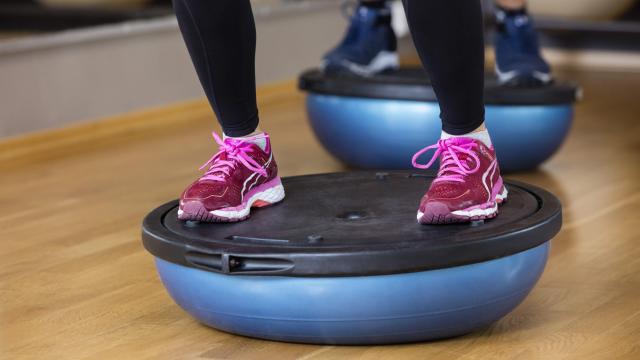Balance boards and Bosu balls are tricky to use — they’re the unstable boards that you’ll sometimes see a personal trainer asking somebody to stand on top of while doing an exercise. But are they a good way to train, and if so, what’s the best way to use them on your own?
They definitely aren’t necessary, but they could be useful in some cases
Plenty of people have made gains in strength and athleticism without using anything like a balance board. So if you’ve never used one and you’re wondering if you’re missing out, don’t worry. You’re not.
So what are they for? These devices challenge your balance and proprioception, which mean your brain gets practice at controlling your muscles to keep you stable, and your muscles get better at sending signals back to your brain about where your body is in space.
If you’re rehabbing an injury, your training program might involve some kind of instability training (as it’s called) to get all the little muscles in your feet and legs working together again. After I had ACL surgery, I remember being assigned to stand on one foot (sometimes with eyes closed, sometimes on a squishy surface) for this purpose.
This type of training can also be helpful for people who are elderly or who have balance problems that could affect their everyday activities. Balance training can make a person better at stabilizing their body, but it also tends to be done under the supervision of a physical therapist or personal trainer for safety reasons. Hopping on a bosu on the gym might be fun, but if you’re able to do it safely on a lark, it’s probably not something you need.
They won’t make a strong person stronger
“A practice that came from physical therapy, it is very useful in rehabilitating injuries back to normal,” the International Sports Sciences Association says of instability training. “But in terms of getting stronger, there’s little evidence that the gains go beyond stability and mobility improvements.”
Balance trainers make exercises harder, but this is more con than pro. If you’re squatting, for example, you mainly want to work your legs and, to a lesser degree, your hips and core. To progressively overload toward those goals, you’ll want to squat with heavier resistance. In other words, don’t add a balance trainer, just put some fucking weight on the bar.
Squatting on a balance trainer will make your squats feel harder, but not by challenging the main movers more. Instead, the instability means more stabilizing muscles need to come to the party. And you’ll be working so hard on getting those stabilizers working that you won’t be able to load up your squat as much as if you were squatting on flat ground.
So if you’d like to work on your stabilizer muscles, give bosus and balance boards a try on their own, and keep the strength-building exercises separate.

Leave a Reply
You must be logged in to post a comment.